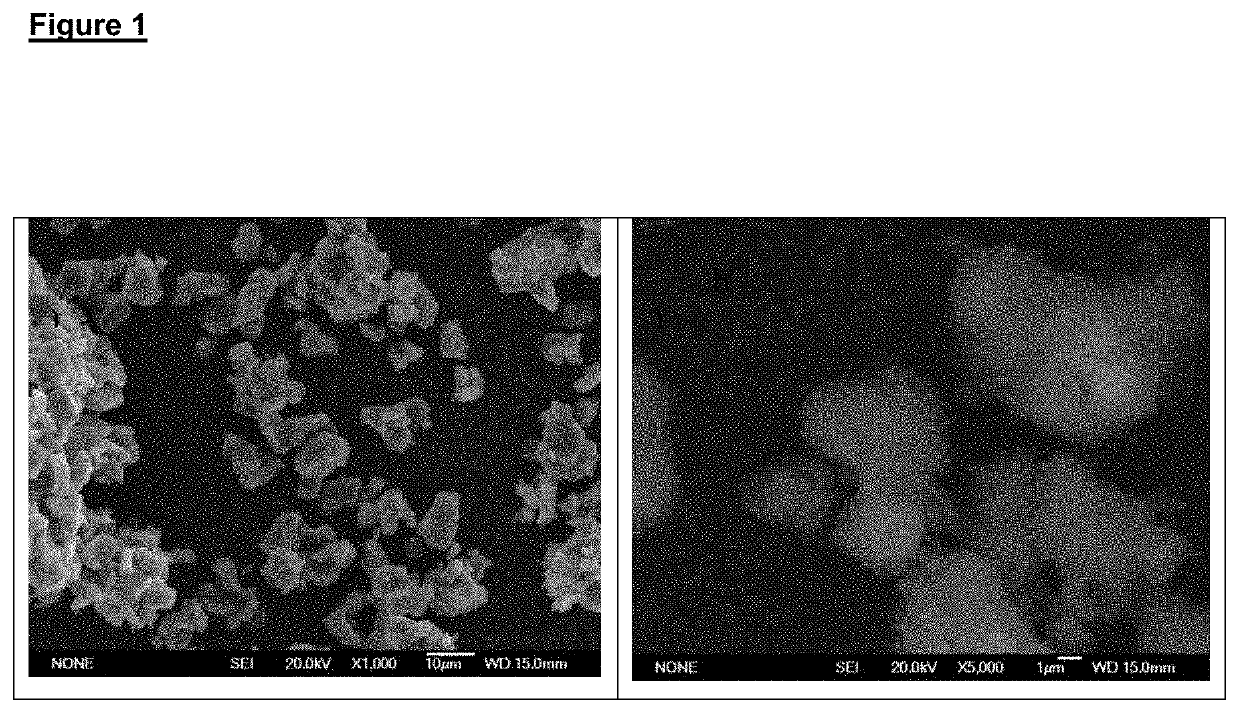Composition of materials for tooth remineralisation
a technology of materials and tooth remineralisation, which is applied in the field of composite materials for tooth remineralisation, can solve the problems of dentin hypersensitivity, increased exposure to further bacterial attack, and further loss of dental tissu
- Summary
- Abstract
- Description
- Claims
- Application Information
AI Technical Summary
Benefits of technology
Problems solved by technology
Method used
Image
Examples
example 1
on, Crystallinity and Dissolution of Different Re-Mineralization Materials Combining Calcium Phosphates and Calcium-Free Silicon Compounds
[0058]By means of acid-base hydraulic reactions generally described in the review by Lawrence Chow [Next generation calcium phosphate-based biomaterials. Dent. Mater. J. 2009 January; 28(1): 1-10] different re-mineralization materials were synthesized (“A” to “H”) and their composition determined as shows in the in the following Table.
Composition of different re-mineralization materialsMaterial #:“A”“B”“C”“D”“E”“F”“G”“H”*Monetite [CaHPO4]42%—20%51%——60%—*Zn-Monetite,—70%——50%57%—[Ca0.97Zn0.03HPO4]*Brushite——65%—————[CaHPO4•2H2O]*Hydroxyapatite——10%——25%20%—[Ca10(PO4)6(OH)2]*Zn-Hydroxyapatite40%[Ca9.7Zn0.3(PO4)6(OH)2]*Calcium metasilicate20%10%— 6% 5%——33%[CaSiO3]Amorphous calcium phosphate11%10%—12%15%11% 8%15%[Ca3(PO4)2•nH2O]Silica gel [SiO2•nH2O],27%10% 5%31%30% 7%12%12%Bioactive glass———— 5%———70SiO2—30CaOTotal crystalline phases62%80%95%57%55%...
example 2
-Mineralization Capacity of Different Re-Mineralization Materials Combining Calcium Phosphates and Calcium-Free Silicon Compounds
[0060]Evaluation of the re-mineralizing capacity of materials of different composition was carried out on dentin discs obtained from human premolar teeth. Enamel was eliminated by sectioning and abrasion, elimination of the detritus from grinding and aperture of the tubules was carried out by subsequent treatment of the dentin surfaces with 0.5M EDTA.
[0061]The different re-mineralizing materials evaluated were mixed with water in a ratio between 2 and 5 ml / gr to obtain a paste that was applied to discs by brushing for one minute and then rinsed with water before immersion in artificial saliva solution at pH 7.2 and storage at 37° C. The process was repeated twice a day for one week. After discs were exposed to an acid medium to simulate acidifying conditions in the oral cavity. Surface of treated discs, before and after the acid treatment, were evaluated b...
example 3
on of Toothpaste Containing Re-Mineralizing Materials Comprising Calcium Phosphates and Calcium-Free Silicon Compounds of the Present Invention
[0062]Re-mineralizing materials with the following estimated compositions “F+”, G+” and “H” shown in the following Table were synthesized for the formulation of the toothpastes.
Re-mineralization materials used in formulation of toothpastesMaterial #:“F+”“G+”“H”Zn-Monetite [Ca1-0.03Zn0.03HPO4]57%29%—Hydroxyapatite [Ca10(PO4)6(OH)2]16%12%—Zn-Hydroxyapatite [Ca9.7Zn0.3(PO4)6(OH)2]——40%Calcium Metasilicate [CaSiO3]—10%33%Amorphous calcium phosphate [Ca3(PO4)2•nH2O]20%17%15%Silica Gel [SiO2•nH2O] 7%32%12%
[0063]Synthesized materials were pulverized for 15 seconds in a ball mil and sieved at 45 microns. Powders obtained for each of the two re-mineralizing materials were mixed in a glass pestle and mortar with non-aqueous liquids for about 3 minutes to obtain a smooth paste with composition of the following Table.
Dentifrice formulationComponent:mass%...
PUM
 Login to View More
Login to View More Abstract
Description
Claims
Application Information
 Login to View More
Login to View More - R&D
- Intellectual Property
- Life Sciences
- Materials
- Tech Scout
- Unparalleled Data Quality
- Higher Quality Content
- 60% Fewer Hallucinations
Browse by: Latest US Patents, China's latest patents, Technical Efficacy Thesaurus, Application Domain, Technology Topic, Popular Technical Reports.
© 2025 PatSnap. All rights reserved.Legal|Privacy policy|Modern Slavery Act Transparency Statement|Sitemap|About US| Contact US: help@patsnap.com



